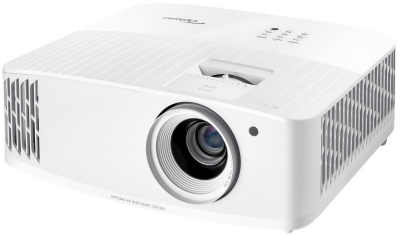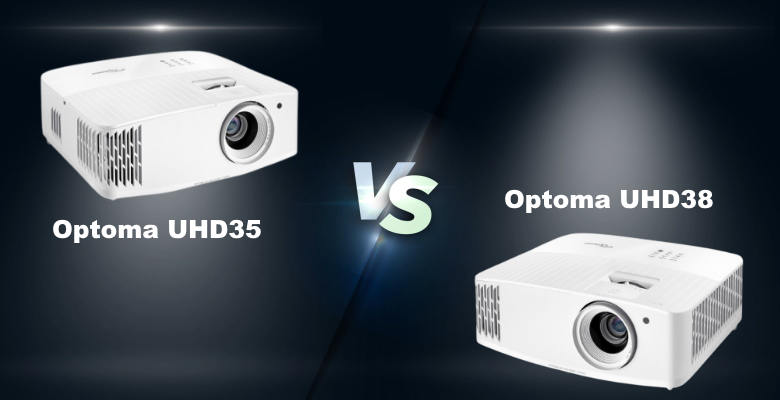Gamers often feel left out when they’re looking for a home theater projector. If they find one with an acceptable lag time, they lose image clarity. It seems like gamers can’t have both. Optoma changed this with their UHD line. You get immersive onscreen images, low input lag, and a fast refresh rate for smooth action frame-by-frame.
Comparing the Optoma UHD35 vs the UHD38, gamers and movie buffs may not notice any differences. Everything from resolution to input lag and throw distance is the same, but the UHD38 produces brighter images (>>> Find on Amazon). If you’re not sure which Optoma gaming projector is the best choice, here’s an in-depth look at their specifications.
Optoma UHD35 vs UHD38 Specifications:
| Optoma UHD35 | Optoma UHD38 | |
|---|---|---|
 |  |
|
| Resolution | 3840x2160 | 3840x2160 |
| Contrast Ratio | 1,000,000:1 | 1,000,000:1 |
| Brightness (Lumens) | 3,600 ANSI | 4,000 ANSI |
| Input lag | 4.2ms | 4.2ms |
| Throw Distance | 4.0' - 32.7' | 4.0' - 32.7' |
| Screen size | 33" - 300" | 33" - 300" |
| Internal Speakers | 10.0 Watts Mono | 10.0 Watts Mono |
| Price | Find on Amazon Bhphotovideo.com | Find on Amazon ProjectorScreen.com Bhphotovideo.com |
As a gamer, you can’t go wrong with either projector, but one may be better suited for you.
Image Quality
Both models are true 4K projectors. You get 8.3 million pixels per frame. It’s a noticeable difference over full HD. Images are crisper and clearer, with more details. Dynamic black technology, plus a 1,000,000:1 contrast ratio ensures deep, inky blacks and brilliant whites. Both projectors are also HDR and HGL compatible and support HDR10 technologies.
An 8-segmented color wheel produces accurate, vivid colors across the Rec. 709 and DCI-P3 spectrums. Colors are realistic and true-to-life. Where the UHD38 wins is with image brightness and clarity. The 3,600 lumens light source on the UHD35 is bright enough to handle most low lighting scenarios, but the UDH38 boasts 4,000 lumens. You get a more vibrant picture with the UHD38 projector.
Better Image Quality: Optoma UHD38
Gaming Quality
Gamers finally have their choice of projectors. Both Optoma models have an impressive lag time of 4.2ms. Love playing first-person shooter games, these projectors can keep up.
Don’t want to lose image quality? If you don’t turn on the gaming mode function, latency speeds are around 16ms. Add in the 240Hz refresh rate and you don’t have to worry about blurry images or a delay in commands from the controller playing out in your game. Image quality drops to full HD in enhanced gaming mode, but with a 4.2ms lag time, the pixel loss isn’t a deal-breaker.
Better Gaming Quality: Optoma UHD35 & Optoma UHD38
Ease of Installation and Set-Up
The UHD35 weighs a little less than the UHD38, but neither projector will break your back during installation. Both are under 10lbs, making them easily portable. Due to the UHD38’s brighter light source, it may be better suited for outdoor movie nights.
Both are standard-throw projectors, they’re not designed for use in smaller spaces. If you live in a dorm or small apartment, you may not be able to cast 100” images. You won’t have any problems aligning onscreen images. Both come with vertical keystone correction, along with 1.1x zoom.
Easier Installation: Optoma UHD38
Optoma UHD35

Gamers can’t complain about the UHD35. The 4K home theater projector lives up to its advertising. If you ignore the enhanced gaming function, input lag is a fast 16ms. You get 8.3 million pixels per scene, along with a latency speed fast enough to keep up with most action games. If you don’t mind dropping to full HD resolution, you get an input lag of only 4.2ms.
It’s not only gamers that love the fast 240Hx refresh rate. It’s also great for movies, TV, and sports. Action sequences are smooth, without any blurring. HDR10 and HLG technologies help ensure images are accurate. An 8-segmented color wheel produces realistic colors, and UltraDetail technology optimizes images as they appear on the screen.
Onscreen images are bright, even in low lighting. The 3,600 lumens lamp ensures you don’t have to black-out the windows. Brighter lights may affect image quality, you want to close the blinds if the room is in direct sunlight.
Pros
- Low input lag
- Flexible installation
- Dynamic black contrast
- 4K resolution
- UltraDetail technology
Cons
- The 8-segmented color wheel can cause rainbowing on action sequences
Optoma UHD38
With a 4K resolution and a 240Hz refresh rate, the UHD38 is designed for gamers and action movie lovers. You get smooth images without fuzzy edges or slow load times. Every action sequence plays out as it’s intended. Lag time, in enhanced gaming mode, is 4.2ms. If you don’t want to drop to full HD, latency speeds are 16ms. It’s still fast enough to keep up with most action and first-person shooter games.
The UHD38 is marketed as a gaming projector, but it’s also designed for movies and TV. You get incredible picture quality, images are crisp and vibrant with accurate colors. Along with a dynamic contrast ratio. The projector support HDR10 and HLG technologies.
Installation is a breeze. Its lightweight construction makes it easily portable, and you won’t have a problem aligning onscreen images. Along with digital vertical keystone correction, it also comes with 1.1x zoom. You can fine-tune images to ensure an optimal viewing experience.
Pros
- Bright light source
- Dynamic contrast
- Low input lag
- 4K resolution
- 3D support
Cons
- The 10-watt speakers do not produce optimal sound to match onscreen images
Summary
Gamers won’t be disappointed in either Optoma 4K projector. Both have low input lags and produce amazing onscreen images. Colors are crisp and clear without any fuzzy edges or blurring. Image quality is also the same, except the UHD38 produces brighter images.
When it comes to value, the UHD35 is the winner. It’s priced lower and delivers almost the same image quality. Where the UHD38 comes out ahead is with its higher lumens rating that produces brighter images in ambient light (>>> Check on ProjectorScreen).
The Optoma UHD35 vs the UHD38 isn’t much of a comparison until you get to price and image brightness. It comes down to where you’ll use the projector, along with what you want to pay for a 4K gaming projector.
REFERENCES:
- Best Projector for Sports – Our Picks
- Best 3D Projector – Buyer’s Guide

